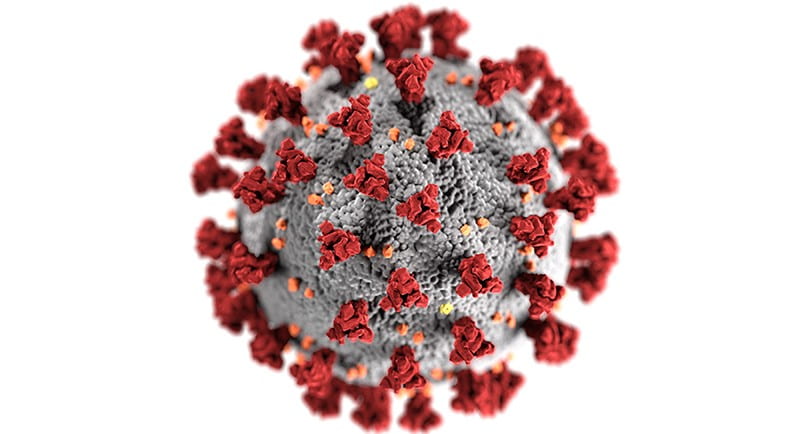In late 2019, an outbreak of Sars-CoV-2, the virus that causes the Covid-19 disease, struck Wuhan, China, ultimately spreading across the globe causing a pandemic. Covid-19 is a strain of coronavirus that targets humans’ respiratory systems, which leads to mild, temporary symptoms, more severe long-term health complications, or death. Panic spread quickly, and given the unfamiliarity of such a large scale public health crisis, people feared the symptoms and effects of this highly contagious virus, and with good reason.
Acute respiratory distress syndrome (ARDS) is a later-stage, extreme effect of many viruses (like influenza) that targets the respiratory system, and has a wide range in case severity. Medical researchers are aiming to define and differentiate between specific types of ARDS, and they hope to then better understand the illness. Researchers performed autopsies on patients with Covid-19-induced ARDS and compared their findings to patients with 2009 H1N1 influenza-induced ARDS. Diffuse alveolar damage (structural damage to the alveoli of the lungs which exchange carbon dioxide and oxygen) and blood clotting in the circulatory system can cause the early effect of ARDS. Among the two patient subject groups, both symptoms were recorded. However, under further statistical analysis, higher levels of angiogenesis, the development of new blood vessels as a part of vasculogenesis, was found in patients who had ARDS resulting from Covid-19. On the contrary, patients who contracted H1N1 were more likely to be in a higher stage (more severe state) of diffuse alveolar damage than patients with Covid-19 who had identical diagnoses. Both of these conclusions show that ARDS is not a uniform complication for all patients or all illnesses. Rather, its severity and symptoms are unique to each virus, and each patient, which justifies more resources and funding being provided to researchers studying the complication.
One such resource, or standard, that is used to classify different types of ARDS is named The Berlin Criteria, and as it is used for the classification of respiratory tract illnesses, it is proving to be an extremely valuable, universal way to layout Covid-19 research, divided into categories of timing, chest imaging, edema (swelling caused by excess bodily fluids), and blood oxygen levels. The criteria focus mainly on patients’ oxygen intake, and its baseline is the appearance of injury from the onset of the virus or the onset of the first symptoms. Specifically, ARDS damages and destroys alveolar epithelial cells (the epithelium is a thin layer of tissue that lines the gastrointestinal tract), which leads to fluid buildup in the alveoli, in turn causing unwanted gas exchange and respiratory complications. The levels of gas exchange and oxygen intake differentiates Covid-19 ARDS from the Berlin Criteria’s standards. Covid-19 patients that have developed ARDS tend to not meet the standards of the Berlin Criteria, with the injury appearing after eight to 14 days compared to the Berlin Criteria’s timing onset of one week. This could lead scientists to wonder about the differences between Covid-19 induced ARDS in comparison to the criteria.
By studying and classifying specific types of ARDS, researchers may eventually be able to classify and standardize ARDS in cases that do not meet the specific criteria of the Berlin Criteria. Not only will this lead to a better understanding of the injury, but will allow scientists to develop meaningful, individualized treatments for cases in the future.
Bibliography
Hariri, L., M.D. ,Ph. D., & Hardin, C. C., M.D. ,Ph. D. (2020, July 9). Covid-19, angiogenesis, and ARDS endotypes. The New England Journal of Medicine. Retrieved November 14, 2020, from https://www.nejm.org/doi/full/10.1056/NEJMe2018629
Lai, C.-C., Ko, W.-C., Lee, P.-I., Jean, S.-S., & Hsueh, P.-R. (2020, August 5). Extra-respiratory manifestations of Covid-19. PubMed. Retrieved November 14, 2020, from https://pubmed.ncbi.nlm.nih.gov/32450197/
Lai, C.-C., Shih, T.-P., Ko, W.-C., Tang, H.-J., & Hsueh, P.-R. (2020, February 12). Severe acute respiratory syndrome coronavirus 2 (SARS-CoV-2) and coronavirus disease-2019 (Covid-19): The epidemic and the challenges (J.-M. Rolain, Ed.). ScienceDirect. Retrieved November 14, 2020, from https://www.sciencedirect.com/science/article/pii/S0924857920300674
Li, X., & Ma, X. (2020, May 6). Acute respiratory failure in Covid-19: is it “typical” ARDS? PubMed. Retrieved November 14, 2020, from https://pubmed.ncbi.nlm.nih.gov/32375845/

